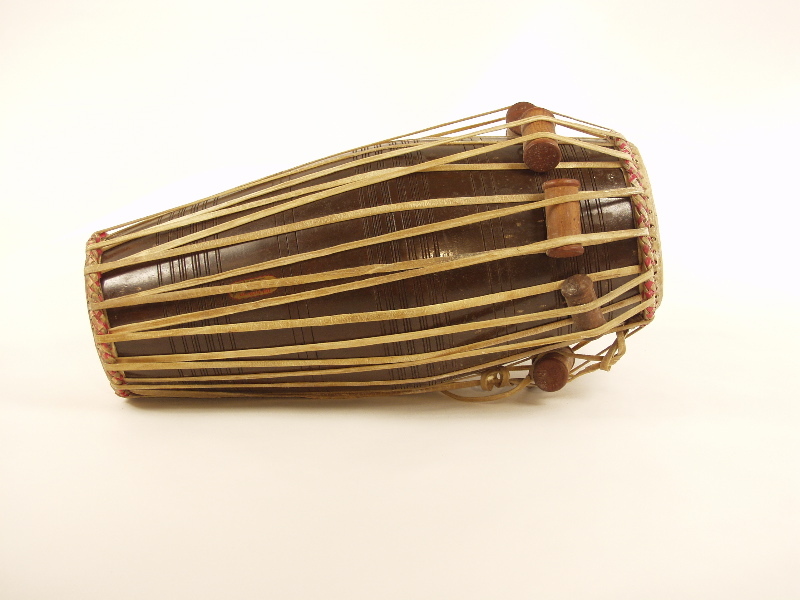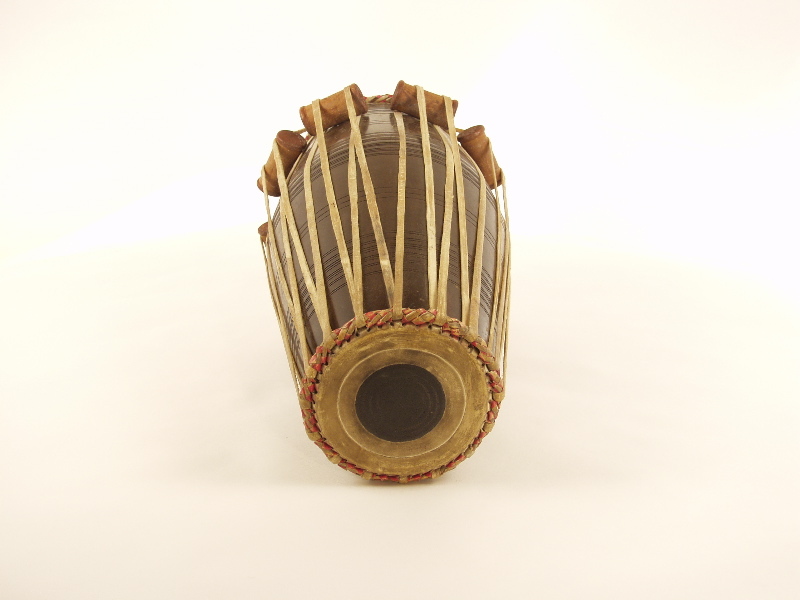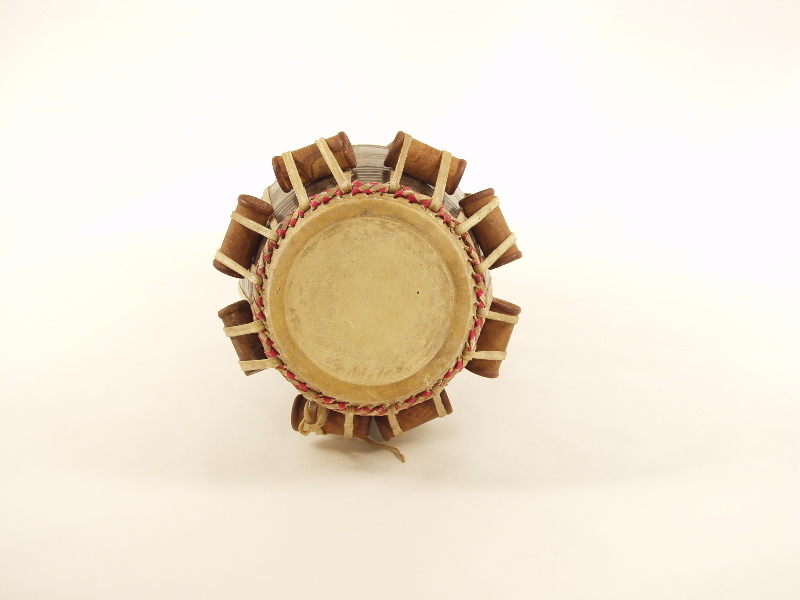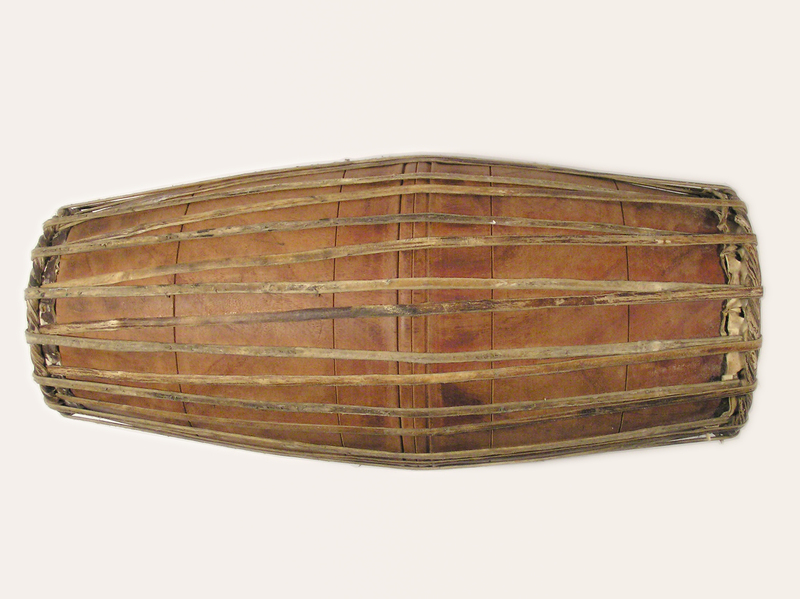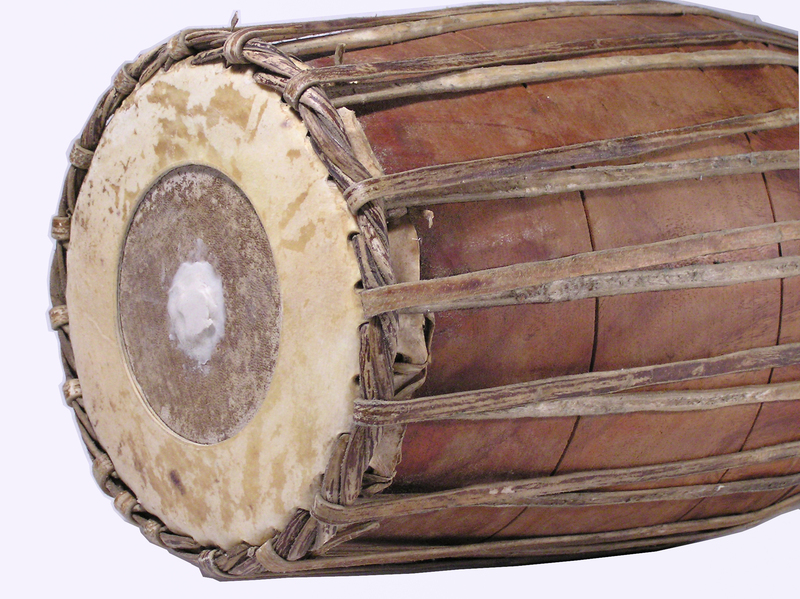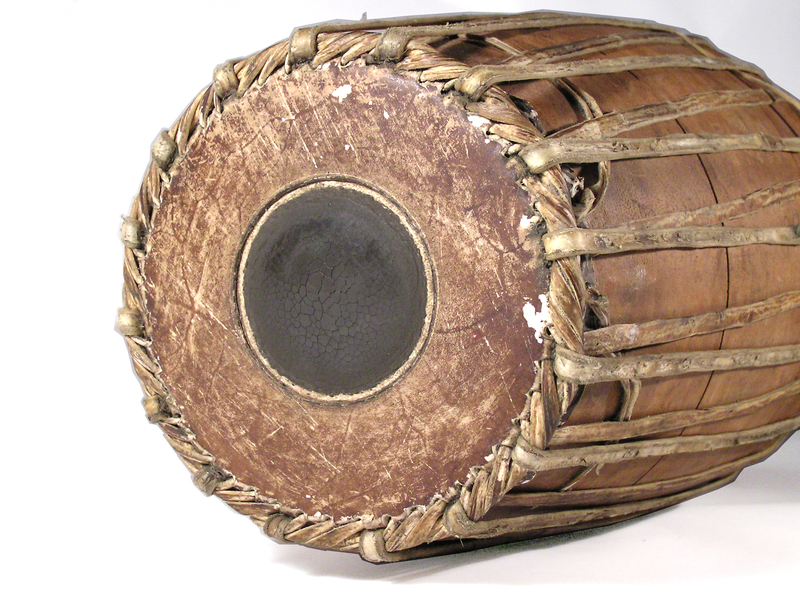Mrdangam
Title
Video
Alternative title
Physical description
The mrdangam has two heads attached to a single hollowed-out wooden shell that is wider in the middle than at the ends. The preferred wood is jackwood, although other wood may be used. Two sizes of shell are in current use. Taggu, or lower-pitched drums, are made on shells approximately 24 inches long with openings at the two ends of 6.75 and 7.75 inches respectively, while hecchu, or higher-pitched drums are made on shells approximately 22 inches long, with openings of 6.5 and 7.5 inches at the two ends.
Right Head:
The right head is made of three layers of animal hide, stitched together with rawhide laces around the circumference of the shell opening. The top and bottom layers are cut out in the center, leaving only the middle layer to stretch uncut across the face of the shell. The bottom layer, usually of calf hide, is cut all the way to the inner edge of the shell. In the center of the middle layer, usually of goatskin, a tuning load is applied. The outermost layer is cut only about 1/8" from the edge of this tuning load, called karunai. This muffles most of the pitches in the overtone series, leaving only the root, octave and fifth as audible. In order to lengthen the decay, pieces of broom straw or fine gravel are inserted between the top and middle layers.
The tuning load has two principal components: slag (waste ore left over from metal refining), which is ground to an ultra-fine powder; and boiled rice. The slag powder and rice are mashed together with a small amount of water to form a compound with a consistency similar to that of modeling clay. It is applied to the head in layers, and over a base of dried rice paste. This rice paste layer is given a rough surface as it dries so that the tuning compound will adhere more easily. A pea-sized ball of the compound is spread evenly over the desired area, then rubbed smooth and dry with the polished surface of a rock.
As the layer dries, a honeycomb pattern of small, even cracks emerges. These cracks persist as subsequent layers are applied and dried. As the load becomes more substantial (a mrdangam may take up to fifty layers of compound), the network of cracks results in a set of columns of the hardened material, all vibrating together when the drum is struck. The precise number of layers, along with the curvature of its surface, is not fixed. The drum-maker strikes the drum frequently as he creates the black spot, deciding after each layer what the next layer's configuration should be. When the drum reaches the desired pitch, the load is finished. Individual pieces of the spot become loose after a long period of playing, creating an unpleasant buzzing sound. When this happens, it is necessary to replace the tuning load.
Left Head:
The left head also comprises three layers of hide. The two outermost layers, of heavy cowhide, are stitched together into a stiff frame cut to a maximum distance of two inches from the shell edge. The inner layer, again goatskin, is tied into this frame and then stretched across the shell. Both right and left heads are held in tension by a continuous strap made of water buffalo hide. In recent years this strap is often replaced by nylon webbing.
The left head also bears a tuning load, in this case temporary. Custom dictates the use of farina (wheat powder) mixed with water then applied to the center of the dampened goatskin. This load, which gives the head its characteristic bass sound of indeterminate pitch, is applied immediately before playing and may be removed and re-applied several times during a performance. In recent years, some mrdangam players have begun to experiment with other, more durable materials for this tuning load. One of the more successful experiments has been the use of silicone caulk, which often outlasts the right head's tuning load. At this writing, however, most well-known mrdangam players are still using the time-honored farina and water.
Historical background
Playing technique
Right Hand:
Tonal strokes are produced by the fingers of the right hand. Typically the index finger strikes and rebounds from the topmost layer of hide, the middle layer, and /or the edge of the black spot, while the ring finger rests on the edge of the spot. This resting ring finger partially damps the sound, producing a pure pitch. This pitch is used to tune the drum to the other instruments in an ensemble. The same stroke without the damping finger produces a pitch a half step higher. With the damping finger in position, there are at least three distinctly named strokes that are produced by the index finger outside the black spot. Some related strokes, designed for fast playing, are made without damping by quickly alternating the index, middle and ring fingers. In these cases, this quickness of movement eliminates the need for damping. Another tonal stroke involves striking the edge of the black spot with the pinkie finger without rebounding. In this case the pinkie does the striking and damping simultaneously. There is one additional tonal stroke, produced by striking across the face of the drum so that the base of the pinkie damps the spot while the rest of that finger strikes and rebounds from the top layer all the way across the head.
The non-pitched strokes are made by striking the black spot itself with one or more fingers. There are at least four of these. In all, there are at least twelve separate right hand strokes.
Left Hand:
There are essentially three left-hand strokes: a flat-handed slap across the goatskin surface, an open, resonant bass stroke on the outer cowhide frame, and an inflected stroke. The inflected stroke is made by striking all the way across the head with one or more fingertips, then sliding the wrist forward onto the goatskin. This slide, by putting pressure on the skin, tightens it and raises the pitch.Notation
Tuning
Geography
Classification
Materials
Date/Era
Additional resources
Sankaran, Trichy. 1994. The Rhythmic Principles and Practices of South Indian Drumming. Toronto: Lalith Publishers.
